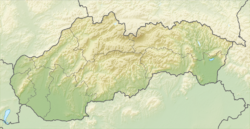- Štvrtok na Ostrove
-
Štvrtok na Ostrove
Csütörtök— village — Location of the village Coordinates: 48°06′00″N 17°21′00″E / 48.1°N 17.35°ECoordinates: 48°06′00″N 17°21′00″E / 48.1°N 17.35°E Country  Slovakia
SlovakiaRegion Trnava District Dunajská Streda First written mention 1217 Named for Thursday Government[1] – Mayor Péter Őry (Party of the Hungarian Coalition) Area – Total 13.066 km2 (5 sq mi) Elevation 128 m (420 ft) Population (2001)[2] – Total 1,679 – Estimate (2008) 1,751 – Density 134/km2 (347.1/sq mi) Etnicity[2] – Hungarians 82,85 % – Slovakians 12,33 % Time zone EET (UTC+1) – Summer (DST) EEST (UTC+2) Postal Code 930 40 Area code(s) +421 31 Website Municipality website (Hungarian)(Slovak) Štvrtok na Ostrove (Hungarian: Csütörtök or Csallóközcsütörtök, Hungarian pronunciation:[’tʃytørtøk]) is a village and municipality in the Dunajská Streda District in the Trnava Region of south-west Slovakia.
Contents
Geography
The village is in the Danubian Lowland and is in the western part of Žitný ostrov (Csallóköz). The municipality lies at an altitude of 128 metres and covers an area of 13.066 km².
Demography
In 1910, the village had 1228, for the most part, Hungarian inhabitants.
At the 2001 Census the recorded population of the village was 1679 while an end-2008 estimate by the Statistical Office had the villages's population as 1751. As of 2001, 82,85 per cent of its population was Hungarian while 12,33 per cent was Slovakian.
As of 2001, 93,81% of the inhabitants professed Roman Catholicism.[2]
History
The earliest extant document referring to the village dates back to 1217, when it was called by it Hungarian name as Villa Ceturthuc.
In the thirteenth century German settlers arrived to the village called in German as Loipersdorf. The village enjoyed Royal privilege to collect tolls and in the fifteenth century it gained the status of a town and had the right to hold markets and develop crafts and trades. Today Štvrtok na Ostrove is basically agricultural.
Until the end of World War I, it was part of Hungary and fell within the Somorja district of Pozsony County. After the Austro-Hungarian army disintegrated in November 1918, Czechoslovakian troops occupied the area. After the Treaty of Trianon of 1920, the village became officially part of Czechoslovakia. In November 1938, the First Vienna Award granted the area to Hungary and it was held by Hungary until 1945. After Soviet occupation in 1945, Czechoslovakian administration returned and the village became officially part of Czechoslovakia in 1947.
Landmarks
- The village is dominated by the late Romanesque church of St Jacob which is mentioned in documents from 1333. The church was altered over the years and the most extensive modifications took place following damage caused by an earthquake in 1590.
- The cultural monuments in the village include the Holy Trinity column, the St. Florian statue of 1893, several roadside crosses and monuments to the victims of the First and Second World Wars.
References
External links
Dunajská Streda • Šamorín • Veľký Meder
Báč • Baka • Baloň • Bellova Ves • Blahová • Blatná na Ostrove • Bodíky • Boheľov • Čakany • Čenkovce • Čiližská Radvaň • Dobrohošť • Dolný Bar • Dolný Štál • Dunajský Klátov • Gabčíkovo • Holice • Horná Potôň • Horné Mýto • Horný Bar • Hubice • Hviezdoslavov • Jahodná • Janíky • Jurová • Kľúčovec • Kostolné Kračany • Kráľovičove Kračany • Kútniky • Kvetoslavov • Kyselica • Lehnice • Lúč na Ostrove • Macov • Mad • Malé Dvorníky • Medveďov • Michal na Ostrove • Mierovo • Nový Život • Ňárad • Ohrady • Okoč • Oľdza • Orechová Potôň • Padáň • Pataš • Povoda • Rohovce • Sap • Štvrtok na Ostrove • Topoľníky • Trhová Hradská • Trnávka • Trstená na Ostrove • Veľká Paka • Veľké Blahovo • Veľké Dvorníky • Vieska • Vojka nad Dunajom • Vrakúň • Vydrany • Zlaté Klasy Categories:
Categories:- Villages and municipalities in Dunajská Streda District
- Hungarian communities in Slovakia
Wikimedia Foundation. 2010.

